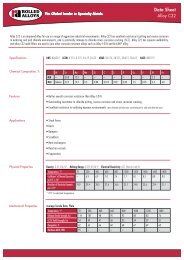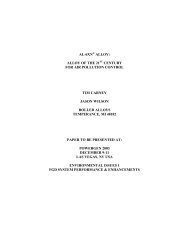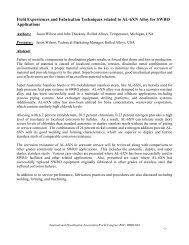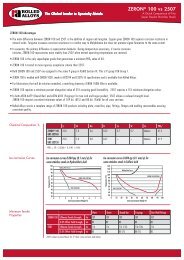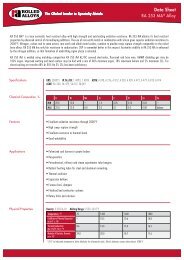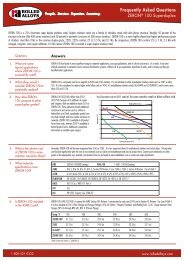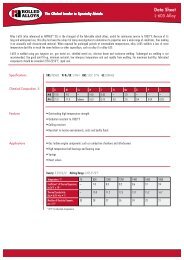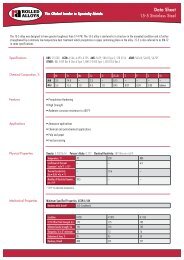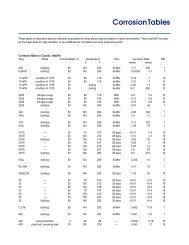2205 Data Sheet.indd - Rolled Alloys
2205 Data Sheet.indd - Rolled Alloys
2205 Data Sheet.indd - Rolled Alloys
- No tags were found...
Create successful ePaper yourself
Turn your PDF publications into a flip-book with our unique Google optimized e-Paper software.
InhaltBedienelementeEingabe des Fluges Quick-Route Einfügen weiterer Punkte Bearbeiten der RouteWetterBeladung und SchwerpunktStart- und LandestreckeFlugdurchführungsformular, einschließlich: Kursen Beladung und Schwerpunkt Start- und LandestreckeAusdruck der StreckenkarteAusdruck von Sichtanflugkarten29.03.2007 Flight Planner, Dr. Peter Luthaus 2
4CORROSION RESISTANCEStress Corrosion Cracking<strong>2205</strong> is a cost effective solution for many applications where 300series stainless steels are susceptible to chloride stress corrosioncracking (SCC).SCC will occur when stainless steels are subjected to tensilestress, while in contact with solutions containing chlorides.Increasing temperatures also increase the susceptibility ofstainless steels to SCC.Table 4 - Stress Corrosion Cracking ResistanceAlloyBoiling Wick42% MgCI ²TestBoiling25% NaCl<strong>2205</strong> F P P316L F F FAL 2003 F P P904L F P/F P/FAlloy 20 F P P317L F F F317LMN F N/A PAL-6XN P/F P PP = Passed F = FailedPitting and Crevice Corrosion ResistanceThe combination of chromium, molybdenum and nitrogen impartthe good resistance of <strong>2205</strong> to chloride pitting and crevicecorrosion. This resistance is extremely important for services suchas marine environments, brackish water, bleaching operations,closed loop water systems and some food processingapplications.ASTM G 48 Practice B is a common method for evaluating thecrevice corrosion resistance of an alloy. Testing is performed ina 10% FeCl ³• 6H ²O solution. Using this test, the critical crevicetemperature (CCCT) of an alloy can be determined. <strong>Alloys</strong> withhigher CCCTs are considered more resistant to crevice attack.Figure 1 - Critical Crevice Corrosion Temp (CCCT)in 10% FeCl ³• 6H ²0Pitting resistance relates heavily to the Cr, Mo and N content of astainless steel. A numerical relationship has been developed forcomparing the pitting resistance of stainlesses based on thesethree elements. This method is known as the Pitting ResistanceEquivalent, PRE N.The following fi gure compares the PRE Nof<strong>2205</strong> to other common corrosion resistant alloys.Figure 2 - Pitting Resistance EquivalentPREN = Cr + 3.3Mo + 16NAL-6XN904L<strong>2205</strong>317LMNAL 2003317L316L0 10 20 30 40 50 60The high chromium, molybdenum and nitrogen contents of <strong>2205</strong>provide corrosion resistance superior to common stainlesses,such as, 316L and 317L in most environments.Structural StabilityUsage of <strong>2205</strong> should be limited to temperatures below 600°F.Extended elevated temperature exposure can embrittle <strong>2205</strong>stainless. Figure 3 shows the temperatures and lengths of timerequired for secondary phases to precipitate in <strong>2205</strong> stainless.Figure 3 - <strong>2205</strong> Time Temperature Precipitation DiagramDegrees F2,0001,5001,0005000Degrees C1,000Phase800600885°FEmbrittlement400Safe Operating Range20000.1 1 10 100Time (hours)AL-6XN904L<strong>2205</strong>317LMNAL 2003317L316L0 20 40 60 80 100 120Temperature, °FPressure Vessel
5Sigma phase will precipitate upon exposure to temperatureswithin the 1300-1800°F range. Precipitation occurs most rapidlyat 1600°F. The presence of sigma phase will cause both a loss inroom temperature ductility and a reduction in corrosion resistance.<strong>2205</strong> mill products are evaluated in accordance with ASTM A 923and are free of harmful levels of intermetallic phases.The welding of <strong>2205</strong> does subject the heat affected zone (HAZ)of the joint to the sigma formation temperature range. The highnitrogen content of <strong>2205</strong> slows the precipitation of intermetallicphases so that welding can be performed without the formation ofharmful levels of sigma phase formation.Exposure to temperatures in the 650-980°F range causes theprecipitation of alpha prime in the ferritic portion of the material.This phenomenon is also referred to as 885°F embrittlement.During welding the time at temperature is typically not longenough to cause embrittlement. 885°F embrittlement limits theuse of <strong>2205</strong> to temperatures below 600°F.FABRICATIONHot FormingHeat <strong>2205</strong> uniformly to 2050-2100°F (1120-1150°C). Do not forgeat temperatures below 1740°F (950°C). Reheat as often asnecessary. Hammer forging is preferred. Dies should havegenerous radii. Cool forgings in air and anneal, followed by waterquench.Hot tearing or surface checking are possible if the initial forgingtemperature is too high. As with other high chromium alloys, <strong>2205</strong>can be sensitive to coarse grinding marks on the forging billet.In order to dissolve undesirable precipitates occurring from the hotforming operations, and to restore the austenite-ferrite balance,the fi nished forging should be heat treated at 1950°F (1070°C)minimum for 10 minutes, or 30 minutes per inch (25mm) ofthickness, water quenched. Rapid heat-up rate is desired to avoiddeveloping second phases. This alloy has very low strength at theannealing temperature, so the workpiece should be wellsupported in the furnace. It is important to cool to below 700°F(370°C) as quickly as possible. If the cooling rate is too slow, itwill lead to decreased corrosion resistance and lowered impactstrength.Cold Forming<strong>2205</strong> stainless can be readily formed and cold worked usingtechniques and designs similar to the basic austenitic stainlesssteel grades. However, due to higher strength and slightly lowerductility, bend radii must be more generous than those used foraustenitic materials. Power requirements for forming operationswill be greater due to the higher yield strength of <strong>2205</strong> stainlessas compared to standard austenitic stainless.<strong>2205</strong> stainless plate can normally be press brake bent over aradius equal to twice the plate thickness. As with other stainlessand nickel alloys, bending over a sharp male die may causethe material to crack. Annealing may be required after 15% colddeformation.Welding ConsumablesGMAW, GTAW and SAW bare wire produced to AWS A5.9,ER2209 (UNS S39209)Nominal Chemistry: 22.5 Cr; 8.5 Ni; 3.1 Mo; 1.6 Mn; 0.4Si; 0.14 NSMAW covered electrodes produced to AWS A5.4, E2209(UNS W39209)Nominal Chemistry: 22.5 Cr; 9.5 Ni; 3.1 Mo; 0.9 Mn; 0.14 NFCAW gas-shielded fl ux cored wire produced to AWS A5.22,E2209-T0-1 and E2209-T1-1 (UNS W39239).Nominal Chemistry: 22.5 Cr; 9.0 Ni; 3 Mo; 1.3 Mn; 0.10 NHeat TreatmentSolution annealing is performed in the range 1870-2010°F(1020-1100°C). Fixture the workpiece to minimize distortion, asthis alloy has low strength at the annealing temperature. The aimpoint for <strong>2205</strong> stainless is 1950°F (1066°C) for at least 10minutes, or 30 minutes per inch (25mm) of thickness, followed bya water quench. Water quench is mandatory. Furnace or aircooling of <strong>2205</strong> stainless is defi nitely not recommended, andwould result in unacceptable mechanical and corrosion properties.Shielded Metal Arc Welding (SMAW)Table 5 - Typical SMAW ParametersElectrodeCurrent,VoltageDiameterAmperes3/32 inch (2.4mm) 50-80 22-281/8 inch (3.2mm) 80-120 22-285/32 inch (4.0mm) 100-160 22-283/16 inch (4.8mm) 160-220 22-28Gas Metal Arc Welding (GMAW)<strong>2205</strong> plate is GMA welded using either the spray arc or pulsed-arctransfer mode. Short circuiting arc transfer is used for welding thinsheets and for out-of-position welding. Pulsing arc transferprovides some of the benefi ts of spray arc at a lower average heatinput, which permits the method to be used on sheet gauges andin all positions. Heat inputs should be maintained around 20-45kJ/inch (0.8-1.8 kJ/mm). The upper end of the range is not critical.Shielding gas is normally 100% welding grade argon having anominal purity of 99.996% and a dew point of -77°F (-60°C).2% nitrogen may be added. Helium may be added if desiredto fl atten the bead contour. Argon-25% helium is desirable to
6get good edge fusion when welding very heavy plate with smalldiameter wire. A newer gas mixture with desirable characteristicsis 95%Ar 3%He 2%N . Do not add oxygen or hydrogen. Oxygen²or hydrogen contamination lowers impact toughness in duplexstainless weldments.Table 6 - Typical GMAW ParametersWire Diameter Direct Current Voltage RangeReverse Polarity0.035 inch (2.4mm) 170-200 24-280.045 inch (1.14mm) 180-260 27-310.062 inch (1.6mm) 230-350 26-32Spray-arc transfer, 100% argon shielding at 24-36 SCFH (11-17 liter/min)Submerged Arc Welding (SAW)When sub-arc welding <strong>2205</strong> stainless, use a highly basic fl ux,such as Avesta Flux 805. Do not use acid fl uxes meant for 18-8stainless. Heat inputs in the range 45-55 kJ/inch (1.8-2.2kJ/mm)are preferred.Table 7 - Typical SAW ParametersWire Size DCPR Current VoltageAmperes3/32 inch (2.4mm) 250-450 28-321/8 inch (3.2mm) 300-500 29-345/32 inch (4.0mm) 400-600 30-35Table 9 - Typical GTAW ParametersFlux Cored Arc Welding (FCAW)Shielding gases used are either 75% argon, 25% carbon dioxideor 100% carbon dioxide. Argon-CO offers the best weldability in²the horizontal position while 100% CO is preferred for vertical²welding.Table 8 - Typical FCAW Parameters with 0.045" (1.14mm)diameter wire75% Ar - 25% CO ²horozontal position100% CO ²vertical positionAmperes DCRP150-25060-110(electrode positive)Volts 22-38 20-24Use stringer beads with very little weave. Weaving will tend to trapslag at the edges of the bead. Allow the metal to cool down below300°F (150°C) between passes.Gas Tungsten Arc Welding (GTAW)With GTAW, use straight stringer beads. Limit dilution of the weldbead by <strong>2205</strong> base metal. This is particularly important in tackwelding and during the root pass. If there is any problem withtack welds or roots cracking it is probably due to insuffi cient weldfi ller, or too low a heat input. Both conditions promote high ferritecontents and reduced ductility in the bead.2% Thoriated Tungstenelectrode diameterDirect Current Straight Polarity(electrode negative) AmperersVoltage Shielding Gas* Argon or argon-2%nitrogen, or argon-helium mixesCFHLiter/min0.040 inch (1.0 mm) 25-80 10-14 25 120.062 inch (1.6 mm) 50-145 12-16 25 120.094 inch (2.4 mm) 135-235 12-16 25 12For light gages, 3/16" (4.8mm) and thinner, heat input should be 20-50 kJ/inch (0.8-2.0kJ/mm) to ensure suffi cient austenite in thefi nished weld bead.* Do not use hydrogen in the shielding gas. This may hydrogen embrittle the weld. Helium may be added to get deeper penetration and faster speeds in automaticwelding.Dissimilar Metal WeldsTo join <strong>2205</strong> stainless to:Suggested Filler Metalcarbon and low alloy steel 316L, 309LMo, 309L*austenitic stainless (304,316, etc.) 316L, 309LMo, 2209, R2209other duplex stainless (2507, alloy 255) 2209, R2209, 2507AL-6XN, Alloy 20, 625, C-276, C-22 or 686 alloys C-276, C-22 or 686*the use of 2209 duplex stainless weld metal on carbon steel may result in a weld with a hard, brittle martensitic zone of about Rockwell C35.
DATA SHEET<strong>2205</strong>UNS S31803, S3<strong>2205</strong>CORPORATE OFFICEROLLED ALLOYS125 WEST STERNS RDTEMPERANCE, MICHIGAN 481821-800-521-03321-734-847-0561FAX: 1-734-847-6917E-MAIL: SALES@ROLLEDALLOYS.COMWWW.ROLLEDALLOYS.COMNORTH AMERICAN LOCATIONS:CALIFORNIA • CONNECTICUT • ILLINOIS • OHIO • OKLAHOMA • TEXASALBERTA • ONTARIOGLOBAL LOCATIONS:CHINA • ENGLAND • FRANCE • GERMANY • THE NETHERLANDS • SCOTLAND • SINGAPORE • SPAINBulletin No. 1009 10/07 1M ©2007 <strong>Rolled</strong> <strong>Alloys</strong>


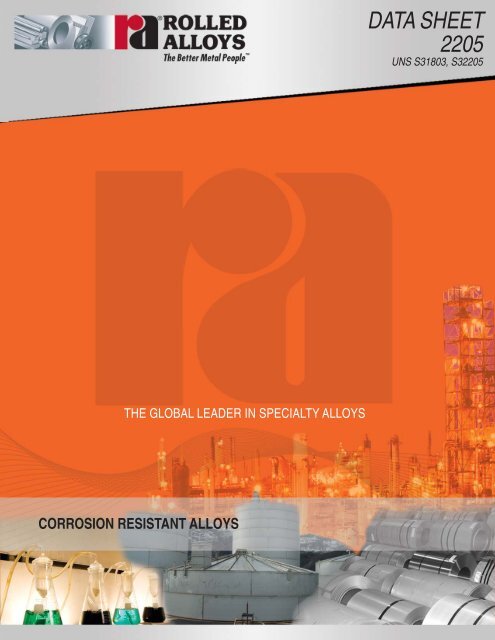
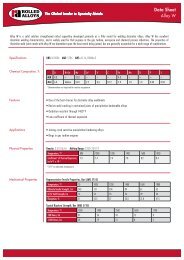
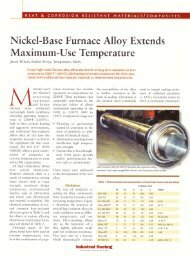
![RA333 Data Sheet [Heat Resistant Alloys] - Rolled Alloys](https://img.yumpu.com/50335849/1/190x245/ra333-data-sheet-heat-resistant-alloys-rolled-alloys.jpg?quality=85)
